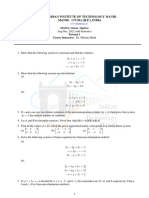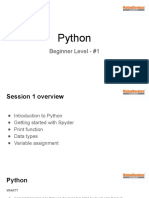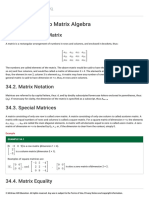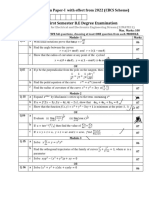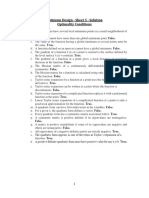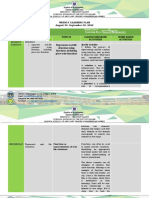Department of Mathematics
Acharya Institute of Technology
Affiliated to VTU, Recognized by GOK and Approved by AICTE, New Delhi(Accredited by NAAC)
Acharya Dr. Sarvepalli Radhakrishnan Road, Acharya P.O., Soladevanahalli, Bangalore-560107, INDIA
www.acharya.ac.in, Email: hod-maths@acharya.ac.in
Title of the Subject: Mathematics –II for CSE stream.
Subject Code: BMATS201
Module-3: Vector Space
1) Define vector space.Show that the set of all ordered n-tuples of the elements of any
field F is a vector space.
2) Show that the set of allm ×n matrices with elements as real numbers is a vector space
over the field (R,+,.) with the usual operation of matrices.
3) Prove that the set of all real valued continuous functions of x defined in the interval
[ 0 , 1 ] is a vector space.
4) Define Vector subspace. Let R be a field of real numbers. Show that the set
W ={( x , 2 y , 3 z)|x , y , z ∈ R } is a subspace of V 3 ( R ) .
5) Show that the intersection of any two subspace of a vector space V (F ) is also a
subspace of V ( F ) .
6) Show that the union of two subspace is a subspace if and only if one is contained in
the other.
7) Prove that the subset W ={(x , y , z )| x , y , z are rational numbers } is not a subspace of
V 3 ( R ).
8) Define Linear Combination of vectors. Express the vector v=(1 ,−2 ,5) as a linear
combination of the vectors v 1=( 1 ,1 , 1 ) , v 2=( 1 ,2 , 3 ) , v 3=(2 ,−1 ,1) in the vector space
3
R ( R) .
9) Write the vector α =( 1 , 7 ,−4 ) as linear combination α 1=( 1 ,−3 , 2 )∧α 2=( 2 ,−1, 1 ) in
the vector space V 3 ( R ) .
10) Express the vector v=(3 , 5 , 2) as a linear combination of the vectors
v 1=( 1 ,1 , 0 ) , v 2=( 2 , 3 , 0 ) , v 3=(0 , 0 ,1) in the vector space R3 ( R ) .
11) Express the matrix A= [ ]3 −1
1 −2
in the vector space of 2x2 matrices as alinear
combinations of B= [ ] [
1 1
0 −1
,=
] [ ]
1 1
−1 0
∧¿
1 1
0 0
[Dec-24/Jan-25]
12) Define Linear Dependence and Linear Independence.
13) For what value of K (if any) the vector Express the vector v=(1 , K ,5) can be
expressed as a linear combination of the vectors v 1=( 1 ,−3 , 2 ) , v 2=( 2 ,−1 , 1 )∈ R3 ( R ) .
14) Find a condition on a , b , c so that w=(a , b , c) is a linear combination of
u=( 1,−3 , 2 ) v=(2 ,−1 ,1) in R3 so that w ∈ span (u , v ) .
15) Determine whether the vectors v 1=( 1 , 4 , 9 ) , v 2=( 3 , 1 , 4 ) , v 3 =(9 , 3 , 12) are linearly
dependent or independent.
� Department of Mathematics
Acharya Institute of Technology
Affiliated to VTU, Recognized by GOK and Approved by AICTE, New Delhi(Accredited by NAAC)
Acharya Dr. Sarvepalli Radhakrishnan Road, Acharya P.O., Soladevanahalli, Bangalore-560107, INDIA
www.acharya.ac.in, Email: hod-maths@acharya.ac.in
16) Determine whether the vectors v 1=( 1 ,2 , 3 ) , v 2=( 3 , 1 ,7 ) , v 3=(2 , 5 , 8) are linearly
dependent or independent. [Dec-24/Jan-25]
17) Prove that the set S= { ( 1 ,0 , 0 ) , ( 0 , 1 ,0 ) ,( 0 , 0 ,1) } is linearly independent in V 3 ( R ) .
18) If u , v , w are linearly independent vectors in V (F ), where F is the field of complex
numbers then { ( u+ v ) , ( v +w ) , (w+u) } is a linearly independent set of vectors.
19) Show that the vector (2 ,−5 , 3) does not belong to the span of
S= { ( 1 ,−3 , 2 ) , ( 2 ,−4 ,−1 ) ,(1 ,−5 , 7) }.
20) Show that the subset S= { ( 1 ,0 , 0 ) , ( 0 , 1 ,0 ) ,( 0 , 0 ,1) } of V 3 ( F ) generates or span the
entire spaceV 3 ( F )
21) Define Basis and Dimension. Determine whether
( 1 ,1 , 1 ,1 ) , ( 1 ,2 , 3 , 2 ) , ( 2 , 5 ,6 , 4 ) ,(2 , 6 , 8 , 5) from a basis of R4 . If not find the
dimension of the subspace they span.
22) Let W be the subspace of R5 spanned by x 1=( 1 ,2 ,−1 ,3 , 4 ) , x 2= (2 , 4 ,−2 , 6 , 8 ) ,
x 3=( 1 , 3 ,2 , 2 ,6 ) , x 4 =( 1 , 4 , 5 ,1 , 8 ) ∧x1= ( 2, 7 , 3 , 3 , 9 ) . [Dec-24/Jan-25]
23) Show that the set S= {( ) ( , )(
2 1 −1 2 0 5
4 3 −2 2 0 −1 1 2 ) ( )}
, ,
3 1
is not a basis of the vector
space of all 2 ×2matrices over R.
24) Define Linear Transformations. If T :V 2 →V 2 defined by
T ( x , y )=(xcosθ − ysinθ , xsinθ+ ycosθ ) then show that T is a Linear transformation.
25) If V is a vector space of polynomial over R. Find a basis and dimension of the
subspace W of V , spanned by the polynomials
3 2 3 2 3
x 1=t −2 t + 4 t+1, x 2=2 t −3t +9 t−1, x 3=t + 6 t−5 and
3 2
x 4 =2t −5 t +7 t +5[Dec-24/Jan-25]
26) Verify whether the following are linear transformations
i) T :V 2 (R)→V 2 ( R ) defined by T ( x , y )=(3 x +2 y ,3 x−4 y )
ii) T :V 3 (R)→V 3 ( R ) defined by T ( x , y , z )=( x 2+ xy , xy , yz )
iii) T :V 3 (R)→V 2 ( R ) defined by T ( x , y , z )=( x+ 2 y −3 z , 4 x −5 y + 6 z )
[ ]
−1 0
27) Find the linear transformation for the matrix A= 2 0 with respect to the bases
1 3
B1={ ( 1 , 2 ,0 ) , ( 0 ,−1 ,0 ) ,(1,−1 ,1) } and B2={ ( 1 , 0 ) ,(2 ,−1) }
[ ]
1 2
28) Find the linear transformation for the matrix A= 0 1 with respect to the bases
−1 3
B1={ ( 1 , 2 ) ,(−2 ,1) } and B2={ ( 1 ,−1 ,−1 ) , ( 1 , 2 ,3 ) ,(−1 , 0 , 2) }
29) Find the matrix representing the transformation T : R 2 → R 3 given by
T ( x 1 , x 2 ) =(3 x 1−x 2 , 2 x 1+ 4 x 2 , 5 x 1−6 x 2) relative to the standard basis of R2∧R 3.
� Department of Mathematics
Acharya Institute of Technology
Affiliated to VTU, Recognized by GOK and Approved by AICTE, New Delhi(Accredited by NAAC)
Acharya Dr. Sarvepalli Radhakrishnan Road, Acharya P.O., Soladevanahalli, Bangalore-560107, INDIA
www.acharya.ac.in, Email: hod-maths@acharya.ac.in
30) Find the matrix of T :V 3 → V 2 define by T ( x 1 , x 2 , x3 ) =(x 1 + x 2 , x 2+ x3 ) with respect to
the bases B1={ ( 1 , 1 ,0 ) , ( 1 , 0 ,1 ) ,(1 , 1 ,−1) } and B2={ ( 2 ,−3 ) ,(1 , 4) }.
31) Define Rank and Nullity of a Linear Transformation.
32) Determine the range space, null space, rank, nullity and verify the rank -nullity
theorem for the following Linear transformation.
i) If T :V 3 (R)→V 2(R) defined by T ( x , y , z )=( y −x , y−z )
ii) If T :V 3 ( R ) →V 4 ( R ) defined by T ( 1 , 0 , 0 )=( 0 ,1 , 0 ,2 ) ,
T ( 0 , 1 , 0 )=( 0 ,1 , 1, 0 ) , T ( 0 , 0 , 1 )=(0 , 1,−1 , 4)
iii) If T :V 3 ( R ) →V 3 ( R ) defined by T ( x , y , z ) =( x+ y , x− y , 2 x + z )
iv) If T : R → R defined by T ( x , y , z )=( x+ 2 y −z , y + z , x + y−2 z )
3 3
[Dec-24/Jan-25]
v) A=
[1 −1 4 3
5 6 −1 1 ]
33) Define Inner product space, Normalization of vector and Orthogonality.
34) Given f ( t )=t +2 , g ( t )=3 t−2 , h ( t ) =t 2−2t−3
1
¿ ⟨ f . g ⟩=∫ f ( t ) g ( t ) dt .
0
Find i ¿ ⟨ f . g ⟩ ∧⟨ f . h ⟩ ii ¿ find ‖f ‖∧‖g‖iii ¿ Normalize f ∧g
[Dec-24/Jan-25]
35) Verify the vectors u=( 1, 1 , 1 ) , v=( 1 ,2 ,−3 )∧w=( 1 ,−4 , 3 ) ∈ R3 are orthogonal or not.














